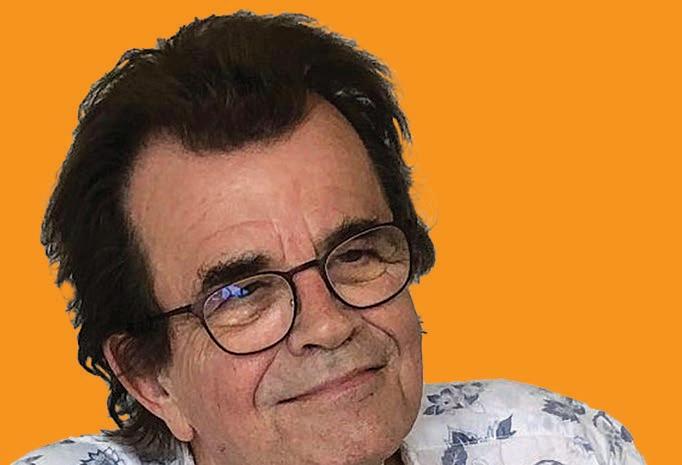
9 minute read
Paul Hopkins
The Fact OfThe Matter

Advertisement


PAUL HOPKINS PAUL HOPKINS Why Putin may lose his propaganda war
In the Boer War at the battle of Spion Kop on January 23, 1900 there were three gures on that hilltop 24 miles southwest of Ladysmith who would survive the ghting and become luminaries in their own right. Louis Botha, a soldier who would become the rst president of the Republic of South Africa; a stretcher bearer by the name of Mahatma Gandhi; and one Winston Churchill, then a correspondent for e Times of London.
Churchill wrote his reporting on the war by hand on reams of paper which were then concealed in an everyday ham sandwich, the would-be lunch of a driver taking his train on the long trek from Durban to Cape Town, from where the ‘sandwiched reportage’ boarded a ship bound for Southampton. All of this arduous operation was to avoid censorship by the authorities. e ‘ ling’ of Mr Churchill’s copy for e Times took about 12 days to see print. Talk about breaking news!
Over a pint in my local I am watching the war in Ukraine, more than 2,000 miles away, unfold frame by frame, e ectively in real time. On a small gadget in the palm of my hand.
I am watching the war on BBC News or CNN or Sky — I constantly switch — but for others, particularly the younger generations, what with Twitter and Insta and Facebook and WhatsApp and Telegram, a veritable ood of videos and sel es of eeing refugees or those under constant bombardment allows us 2,000 miles away to identify Russian tanks rolling over Ukrainian bridges and Russian helicopter gunships blasting mercilessly away at people’s homes.
Yet, for all of the visuals of death and mayhem surging across the internet, one wonders whether they are, in any real way, helping people understand the unfolding moment-by-moment horror. Is too much knowledge a dangerous thing, in that it desensitises us? I would suggest, too, that the intensity and immediacy of social media are creating a new kind of ‘fog of war’, in which information and disinformation are continuously entangled with each other — clarifying and confusing in almost equal measure. e modern combination of smartphones, social media and high-speed data links are providing images that are now certainly faster, more visual and more voluminous than in any previous military con ict. e mass mobilisation of Russian military forces has been broadcast for weeks on TikTok, the newest and fastest growing social media app, with hundreds of videos from nearby onlookers showing the movement of ballistic missiles and armoured vehicles.
Such media outlets, however, have also brought, I would contend, new e orts to deceive, while the war is unfolding alongside an aggressive and widely distributed campaign of disinformation heralded by Vladimir Putin that makes it dif cult at times for ‘crowdsourcing’ to establish the facts on the ground.
Still, there is a positive aspect to all this. Before the war, Kyiv Digital was the o cial city app for Ukrainians to buy tickets for transport and pay for parking or utility bills in the country’s capital. Now Kyiv Digital has been transformed into a lifesaving tool that warns of air raids, and directs people to the nearest bomb shelter or safe house. With the help of the country’s chief digital transformation o cer – Kyiv Deputy Mayor Petro Olenych – the app’s focus changed within just 24 hours of the Russian invasion.
And another thought. After the invasion of his country, Ukraine’s Minister for Digital Transformation Mykhailo Fedorov launched a campaign urging global technology companies to withdraw from the Russian market — to join the growing group of rms across many industries that have called it a day with Moscow. “ ey kill our children, now kill their access!” he tweeted at Apple.
e Russian regime has made substantial use of Staterun ‘news’ channels on social media to spread propaganda both at home and abroad, but the growing opposition and everyday civilians gain just as much — if not more — from the ability to see and to share real stories on other media that diverge from the Kremlin narrative. is is especially true now that Russia’s independent media have been silenced.
Information technology has gained a signi cant foothold in Russia, making it di cult for the State to blot out the messages it abhors, and the country’s younger people have been exposed to too many Western experiences, through travel and social media, to ever again swallow whole Putin propaganda.
By all accounts, Mr Putin, already losing the war, is also losing his extended propaganda war on the home front...
See also, Page 14




Man (60) dies in house fire
ONE man died and his brother was injured trying to rescue him after a re started in the middle of the afternoon at their Kilkenny family home.
Oliver Brennan, aged in his 60s, was killed when the blaze broke out on at the house in the Jenkinstown Park area of Kilkenny city.
His sibling Dominic discovered the blaze when he returned to the house and was injured attempting to get inside before being forced back by the ames.
He was later treated for smoke inhalation. Gardai are treating the re as an accident.
Speaking on KCLR96FM, Fianna Fáil Councillor Pat Fitzpatrick and friend of Mr Brennan’s described him as, “a quiet, quiet man, who would love to have a chat”.
Cllr Fitzpatrick said: “I would like to o er sympathy to his brother Dom. He lived with Oliver. I worked alongside him (Oliver) in the box company in the Hebron Industrial Estate. I knew him a long time.”
He explained that Mr Brennan’s brother Dominick returned to the house to an “unfolding scene”.
“Oliver passed away in sad and tragic circumstances. He was from a big family, there were 10 in the family. Dominic was away from the house that morning. I spoke to him on John’s Green myself that morning.
“ e pair lived together. It’s a terrible, terrible tragedy. e two lads were always happy to know what was going on and had a big interest in GAA. Poor Oliver is gone to his eternal reward. A nicer man you would not meet”. e victim is survived by his brothers Peter and Dominic, sisters Breda, Margaret, Alice and Terry. His brothers-in-law Shem, Eamonn, Pat and Martin, sister-in-law Marie and extended family.
Voice of young in vital discussions


MORE than 200 young people from across Ireland tackled a wide range of issues under the overarching theme of equality at Dáil na nÓg 2022 which recently took place at Dublin’s Convention Centre. is year marks the 20th anniversary of the biennial event which platforms the voices of young people on the issues which matter most to them. Minister for Children, Equality, Disability, Integration and Youth Roderic O’Gorman engaged with young people at the event. is year’s event explored the theme of equality as young people, through their local youth councils (Comhairle na nÓg), have been investigating the challenges and opportunities in a variety of areas including mental health, climate change, body image, drugs and alcohol, youth facilities and LGBTIQ+. is theme was chosen by young people as the area of most importance to them and a vote took place on three areas of equality on the day.
Previous years’ themes included climate action, education, and transport. In 2019, a debate and vote on sustainable transport solutions saw delegates from the Comhairle na nÓg councils propose a new policy to o er reduced fares to young people in response to the recognised need to reduce carbon emissions and promote sustainable transport options; this was successfully introduced by Government in Budget 2021 as well as the Government’s Climate Action Plan.
Participants at Dáil na nÓg 2022 were looking to in uence policy at Government level to advance the areas of equality they see as important.
A panel discussion saw Cllr Yemi Adenuga, Ireland’s rst black female elected representative, RTE Radio DJ and LGBTQI+ advocate Stephen Byrne, Children’s Rights Alliance CEO Tanya Ward, and Aoife Price, disability advocate with Disability Women Ireland engage in an exciting discussion on equality.


Homes for seniors get €1.97m. funding
THE Minister for Heritage and Electoral Reform, Malcolm Noonan TD, today (28 March 2022) announced €1.97 million in funding for Housing Adaptation Grants for older people and people with a disability living in Kilkenny. e allocation is an increase of €27,375 on 2021 and continues the year-on-year increases in the grant since 2014.
Grants of up to €30,000 are available to assist disabled people in carrying out necessary works to make a house more suitable for their needs. Additionally, grants of up to €8,000 are available to assist older people to have necessary repairs or improvements carried out on their homes and grants of up to €6,000 are available for mobility aids.
Minister Noonan said: “I am delighted to be in a position to allocate increased funding to Kilkenny County Council so that they can continue to support older people and disabled people to live independently in Kilkenny.
“Importantly, home adaptations help reduce the dependency on our health services by supporting independent living for as long as possible and in other instances facilitate an early return from hospital, taking pressure o already over-burdened services.
“ ese grants will also provide a boost to Kilkenny’s economy, creating employment opportunities for local contractors,” the minister said.
“I am pleased that funding for Kilkenny County Council to administer this scheme has been increasing year-on-year since 2014. is shows the importance that is attached to the scheme and the Government’s commitment to older people and disabled people.
“ ese grants have a huge impact on the quality of life of the many bene ciaries in Kilkenny and play a vitally important role in helping disabled people and people who are reaching an age in life when they are less mobile, " he said. e fund, supports home adaptations for older people, disabled people and those with mobility issues, provides 80% Exchequer funding.





